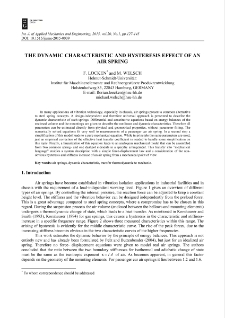Zielonogórska Biblioteka Cyfrowa udostępnia 65 391 obiektów cyfrowych
Obiekt
Tytuł: The dynamic characteristic and hysteresis effect of an air spring
Współtwórca:
Tytuł publikacji grupowej:
Abstract:
In many applications of vibration technology, especially in chassis, air springs present a common alternative to steel spring concepts. A design-independent and therefore universal approach is presented to describe the dynamic characteristic of such springs. Differential and constitutive equations based on energy balances of the enclosed volume and the mountings are given to describe the nonlinear and dynamic characteristics. ; Therefore all parameters can be estimated directly from physical and geometrical properties, without parameter fitting. The numerically solved equations fit very well to measurements of a passenger car air spring. In a second step a simplification of this model leads to a pure mechanical equation. While in principle the same parameters are used, just an empirical correction of the effective heat transfer coefficient is needed to handle some simplification on this topic. ; Finally, a linearization of this equation leads to an analogous mechanical model that can be assembled from two common spring- and one dashpot elements in a specific arrangement. This transfer into "mechanical language" enables a system description with a simple force-displacement law and a consideration of the non-obvious hysteresis and stiffness increase of an air spring from a mechanical point of view.
Wydawca:
Zielona Góra: Uniwersytet Zielonogórski
Format:
Identyfikator zasobu:
DOI:
Strony:
Źródło:
IJAME, volume 20, number 1 (2015)
Jezyk:
Licencja:
Licencja CC BY-NC-ND 4.0:
Prawa do dysponowania publikacją:
Biblioteka Uniwersytetu Zielonogórskiego
Kolekcje, do których przypisany jest obiekt:
- Zielonogórska Biblioteka Cyfrowa > Repozytorium > Jednostki organizacyjne > Wydział Mechaniczny
- Zielonogórska Biblioteka Cyfrowa > Repozytorium > Typy utworów > Artykuły
- Zielonogórska Biblioteka Cyfrowa > Repozytorium > Czasopisma naukowe i serie wydawnicze UZ > International Journal of Applied Mechanics and Engineering (IJAME)
- Zielonogórska Biblioteka Cyfrowa > Repozytorium > Czasopisma naukowe i serie wydawnicze UZ > International Journal of Applied Mechanics and Engineering (IJAME) > International Journal of Applied Mechanics and Engineering (IJAME) (2015)
Data ostatniej modyfikacji:
6 lip 2023
Data dodania obiektu:
12 kwi 2023
Liczba wyświetleń treści obiektu:
237
Wszystkie dostępne wersje tego obiektu:
https://zbc.uz.zgora.pl/publication/80766
Wyświetl opis w formacie RDF:
Wyświetl opis w formacie OAI-PMH:
| Nazwa wydania | Data |
|---|---|
| The dynamic characteristic and hysteresis effect of an air spring | 6 lip 2023 |
Obiekty Podobne
Pańtak, Marek Jarek, Bogusław Kuczyński, Tadeusz - red.

